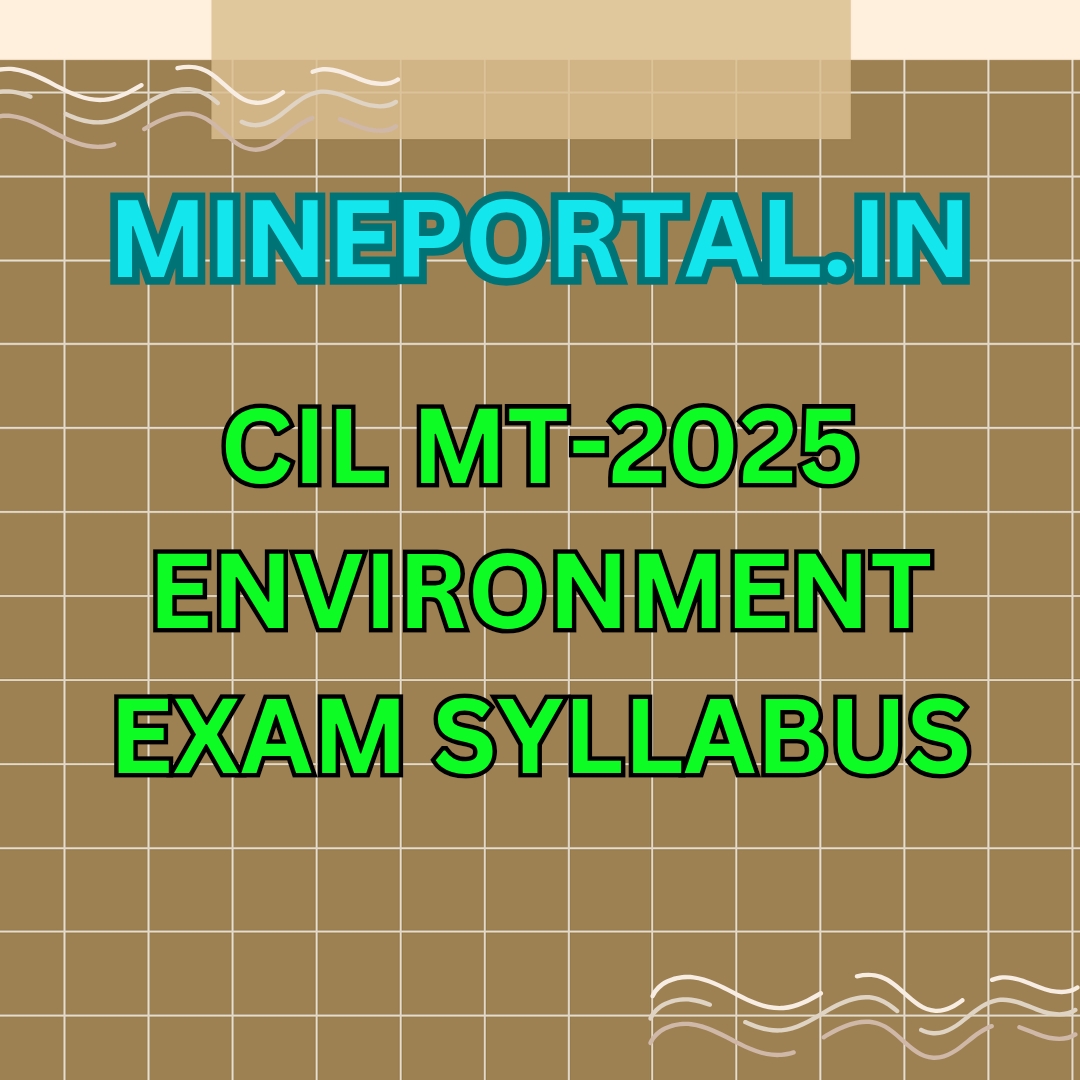
CIL MT-2025 ENVIRONMENT EXAM SYLLABUS
COAL INDIA LTD MANAGEMENT TRAINEE EXAM-2025 ENVIRONMENT EXAM SYLLABUS
Fundamentals of Environmental Sciences
- Structure and composition of atmosphere, hydrosphere, lithosphere and biosphere.
- Meteorological parameters- pressure, temperature, precipitation, humidity, mixing ratio, saturation mixing ratio, radiation and wind velocity, adiabatic lapse rate, environmental lapse rate. Wind roses.
- Interaction between Earth, Man and Environment. Biogeographic provinces of the world and agro- climatic zones of India. Concept of sustainable development.
- Natural resources and their assessment. Remote Sensing and GIS: Principles of remote sensing and GIS. Digital image processing and ground trothing. Application of remote sensing and GIS in land cover/land use planning and management (urban sprawling, vegetation study, forestry, natural resource), waste management and climate change.
- Environmental Education and awareness, Environmental ethics.
- Basis of Ecosystem classification, Types of Ecosystem.
- Biodiversity and its conservation: definition, types, importance of biodiversity and threats to biodiversity. Concept and basis of identification of ‘Hotspots’; hotspots in India. Measures of biodiversity. National parks, Sanctuaries and Protected area in India.
Energy and Environment
- Sun as source of energy: Solar radiation and its spectral characteristics. Fossil fuels:classification, composition, physio-chemical characteristics and energy content of coal, petroleum and natural gas. Shale oil, Coal bed Methane, Gas hydrates. Gross- calorific value and net calorific value.
- Environmental implications of energy use: energy use pattern in India and the world, emissions of CO2 in developed and developing countries including India, radiative forcing and global warming. Impacts of large scale exploitation of Solar, wind, hydro and nuclear energy sources, Carbon footprint, Trading, GHGs.
ENVIRONMENTAL POLLUTION AND CONTROL
Air and Noise Pollution
- Sources and Type of Pollutants- Natural and anthropogenic sources, primary and secondary pollutants. Criteria air pollutants.
- Sampling and monitoring of air pollutants (gaseous and particulates), frequency and duration of sampling. Principles and instruments for measurements of ambient air pollutants concentration.
- Impact of air pollutants on human health, plants and materials.
- Air Pollution Standards: National Ambient Air Quality Standards- 2009,
- GSR(742)E-2009.
Noise Pollution
- Sources, weighting networks, measurements of noise indices (Leq, L10, L90, L50, LDN, TNI). Noise dose and noise pollution standards. Noise control and abatement measures: Impact of noise and vibration on human health.
Water Pollution
- Types and sources of water pollution. Impact on humans, plants and animals. Measurement of water quality parameters: sampling and analysis for pH, EC, turbidity, TDS, hardness, chlorides, salinity, DO, BOD, COD, nitrates, phosphates, sulphates, heavy metals and organic contaminates.
- Microbiological analysis- MPN. Indian standards for drinking water treatment: Coagulation and flocculation, Sedimentation and Filtration, Disinfection and softening.
- Wastewater Treatment: Primary, Secondary and Advanced treatment methods. Common effluent treatment plant. Effluent water quality standards.
Solid and Hazardous Waste Management
- Integrated Solid waste management: Waste hierarchy: Rules and regulation for solid waste management in India. Municipal Solid waste management: Sources, generation, characteristics, collection and transportation, waste processing and disposal.
- Hazardous waste management: Characteristics, generation, fate of materials in the environment, treatment and disposal. Management of biomedical waste, plastic waste and E-waste: Sources, generation and characteristics, waste management practices including storage, collection and transfer.
Global and Regional Environmental Issues
- Global effects of air pollution – Greenhouse gases, global warming, climate change, Intergovernmental Panel on Climate Change (IPCC), Urban heat Islands, Acid rain, Ozone hole, Factors influencing increases in population, energy consumption and environmental degradation.
- National Clean Air Program, National Action Plan on Climate Change (Eight National Missions- National Solar Mission, National Mission for Enhanced Energy Efficiency, National Mission for Sustainable Habitat, National Water Mission, National Mission to sustain the Himalaya Ecosystem, National Mission for ‘Green India’, National Mission for Sustainable Agriculture, National Mission for Strategic knowledge for climate change.
Environmental Management and Sustainable Development
- Environmental Management System, Environmental auditing, Environmental Impact Assessment, Utilisation of Fly Ash, Life Cycle assessment
- Environment Policies – Environmental Policy, Indian Forest Policy, Objective: Polluter pays principle,
- Environment Legislation:
- Principle and Policies in India: National Environment Policy 2006, National Forest Policy 1988, Polluter Pays Principle, Comprehensive Environmental Pollution Index (CEPI), Principles of International Law and International treaties.
- Environment related Acts (with amendments) and rules made thereunder: The Water and Air Acts The Water (Preventions and Control Pollution) cess Act, 1977, The Environment (Protection Act (EPA) 1986, Indian Forest Act 1927, Forest (Conservation) Act 1980, Wildlife (Protection) Act 1972, National Green Tribunal Act, 2010, The Public Liability Insurance Act 1991, Biological Diversity Act 2002, The Schedule Tribes and other Traditional Forest Dwellers (Recognition of Forest Rights) Act, 2006.
- Energy and Environment: Energy Sources- Overview of resources and reserves: Renewable and non-renewable energy sources: Energy- Environment nexus.
- Sustainable Development: Definition and concepts of sustainable development: Sustainable development goals: Hurdles to sustainability.
- Global Best practices for Environment protection and sustainable development.
Note*- The above syllabus is indicative in nature and not Exhaustive. The Topics, Acts
and Rules mentioned above includes the latest concepts in existence with regard to the
specified topics and in respect of Acts/Law, latest amendments upto date.


No comments added yet!